Wood flooring decorated and colored
Post from EditorialsThe parquet floor is very popular because of its versatility and beauty, from this you can get unique and very colorful floors, here is how.
Technique of marbling on wood
The wood is one of the most used materials in the construction industry, because of its structural function to the decorative one, in fact, it is used both to create decorative elements such as floors and walls, and pieces of furniture with a wide variety of shapes and functions. 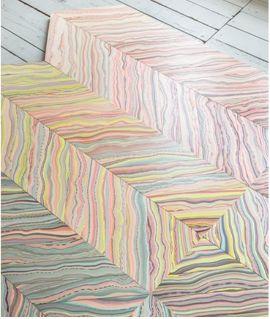 The wood in addition to having features of beauty and eco-sustainability, from a physical and mechanical point of view, is a very flexible and adaptable material, and this leads to a unique ease of processing.
The wood in addition to having features of beauty and eco-sustainability, from a physical and mechanical point of view, is a very flexible and adaptable material, and this leads to a unique ease of processing.
The wood in construction and architecture, from the most traditional to the most modern one, lends itself, as it has always did, to undergo any change with regard to its appearance.
In fact, there are architectural and design solutions that use the wood material in its natural state, while others who use the colors by painting the elements of wood and giving it a look out of the ordinary.
The technique of marbling is a technique of painting very old, which was used by the Danish Pernille Snedker Hansen, by Snedkerstudio, to work the wood.
This technique has Scandinavian origins and involves the use of pine wood for the production of coatings. The origin of marbling are Japanese, the Japanese term literally translates as the floating ink art.
Although the term leads to think exactly the opposite, in fact the technique of marbling is very simple: to realize it we need to get a large and flat container that will be filled with water.
On the surface of the water we must let fall some ink droplet, previously mixed with an oily substance that allows the expansion of the drop of color to form a random spot. Made for the effects of the most diverse with the grain of the strangest and most original veining, you can use different colors than mingling with one another, create very specific nuances.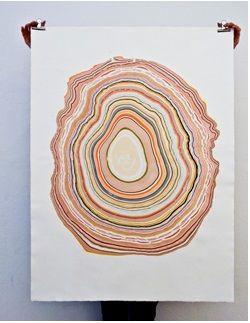 The final effect exactly because of the presence of different colors and veins remind of the natural marble. After doing all this we place it on the surface of a sheet of paper, the design that automatically appears on the water is transferred to the paper becoming a real painting.
The final effect exactly because of the presence of different colors and veins remind of the natural marble. After doing all this we place it on the surface of a sheet of paper, the design that automatically appears on the water is transferred to the paper becoming a real painting.
The artist Pernille uses the same technique but using not a sheet of paper but a sheet of wood, then these panels are used as decorative elements. The particularity of these drawings is that each one is unique and different from the other, since the trend of the ink mixed in this oily substance, takes in turn a trend always different.
On wood panels this thing is highlighted, since the panel or the wood element is not smooth, but is characterized by numerous elements in relief that characterize the surface, such as grain or the concentric waves that are of a natural type and that are highlighted precisely with the use of these colors. 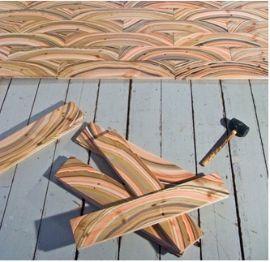 Using this technique it is possible to obtain unique surfaces, to be used both for floors and walls.
Using this technique it is possible to obtain unique surfaces, to be used both for floors and walls.
Here's how from a simple pine tree you can get different results every time transforming any interior in a rainbow of colors.
The floor and the panels are made of wooden planks that are realized by hand, one by one, and the combinations that can be obtained, placing them one next to the other, are endless.
The parquet rainbow, this is the name that was given to it, was nominated in 2011 for the Biennial Prize at the Biennale Danish craft and design.
Wood, a non-toxic, eco-friendly, durable and creative material
The modern architecture also provides us with other opportunities to make colored parquet and wooden floors able to give that touch of uniqueness to interiors. A company leader in this field is TABU, which differs from the others for the realization of original wood floors and unique, which are made using the multi-layered wood that is exactly eco-friendly, non-toxic, durable, dyed throughout its thickness.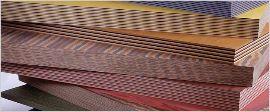 The parquet TABU combine the features of a traditional parquet to the advantages of the multi-laminar wood, namely a better running in a short time, since simple to lay in work, but at the same time a higher density and strength and maintenance very simple.
The parquet TABU combine the features of a traditional parquet to the advantages of the multi-laminar wood, namely a better running in a short time, since simple to lay in work, but at the same time a higher density and strength and maintenance very simple.
This type of flooring can be sanded and re-painted, it can be laid on new slabs, old existing floors or carpet. The multi-layered wood is so called because in fact it consists of many thin layers of different wood species, after being individually colored, are paginated and assembled, in this way you can get infinite different textures.
To achieve these foils, the wood is treated so as to eliminate all the harmful substances and make so the wood is not attacked by parasites. The dyes used for the dyeing of wood are sourced from selected manufacturers that operate in compliance with both the environment, and the laws in force concerning toxicity.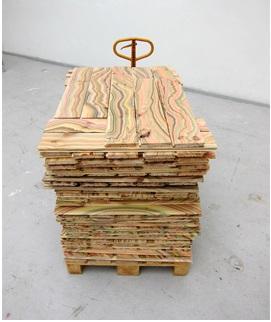 Therefore the possibility to color the wooden slats that make up the parquet, allows to obtain solutions more extravagant in terms of finishes, so sometimes we speak of drawings or designs already set by the company also designed and proposed by the same contractor who in this way can leave plenty of room for his imagination.
Therefore the possibility to color the wooden slats that make up the parquet, allows to obtain solutions more extravagant in terms of finishes, so sometimes we speak of drawings or designs already set by the company also designed and proposed by the same contractor who in this way can leave plenty of room for his imagination.
The multilayered parquet floors different from classic to all of its features is actually subject to the same maintenance techniques.
The varnish layer, while having characteristics of hardness and durability is sensitive both to the action of chemical agents such as acids, both of physical agents such as pebbles under the shoes, sharp objects, furniture being dragged.
The dark shades of wood floors tend to make these signs more evident than light colors. To protect it from all these agents at least in part is advisable to apply on the surface of the flooring a layer of wax. The waxes to be used can be of two types. The water-soluble wax metallized should be stretched a first time with a rag not overly wet, then diluted in a percentage of water approximately equal to 60-70%. Later, according to need, you will have to clean the floors with a damp cloth with a water solution 90% and 10% water-soluble wax. The other type is the non-silicone wax. This is much thicker than the previous one and should be lying on the floors dry with a cloth of wool or through the use of the polisher.
79810 REGISTERED USERS










